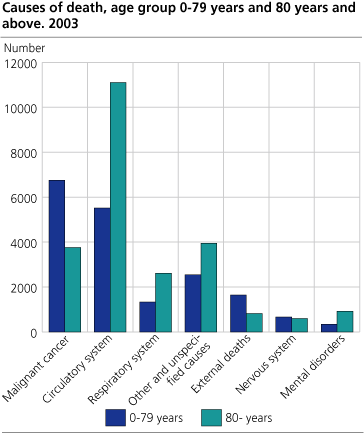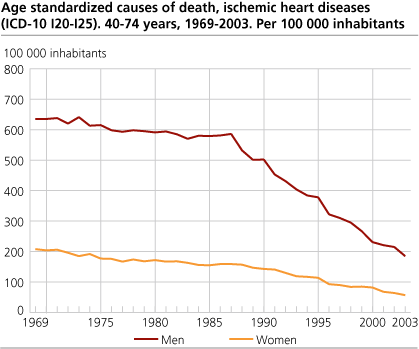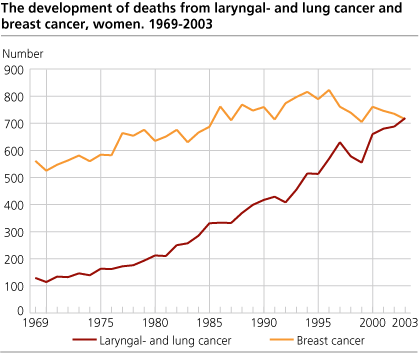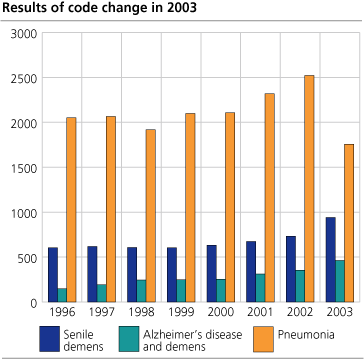Content
Published:
This is an archived release.
Decline in circulatory deaths
The number of circulatory deaths among men under the age of 70 and women under the age of 80 has never been lower in the last hundred years. Diseases in the circulatory system caused 39 per cent of all deaths in 2003, compared with 49 per cent in 1979.
There were 42 550 deaths in 2003; 20 595 men and 21 955 women. 93.3 per cent died of diseases and 5.4 per cent of external causes while the cause of death was unknown in 1.3 per cent of the cases.
Malignant neoplasms and circulatory diseases
Figure 1 shows that the most frequent cause of death for people under the age of 80 is cancer, while for those over 80 years the most frequent causes of death are diseases in the circulatory system. While diseases in the circulatory system caused 39 per cent of all deaths in 2003, the percentage in 1979 was 49. In comparison, deaths caused by cancer have increased from 21 to 25 per cent in the same period.

Decrease in deaths from circulatory diseases
Deaths caused by diseases in the circulatory system constituted 39 per cent of all deaths in 2003. Between 1962 and 1974 the percentage was 50 per cent. The percentage from 2003 is the lowest that has been registered in the last 50 years. For men under the age of 70 and women under the age of 80 the number of such deaths has never been lower in the last hundred years, which is the period in which reliable statistics are available. For the older age groups we have to go back to the Second World War to find equally low figures.
Over the last 35 years there has been a marked decline in ischemic heart diseases. For men aged 40-74 years, the relative decrease has been around 70 per cent in this period.

Increase in deaths from lung cancer
Almost 2 000 people die of lung cancer every year. This is ten times as many as in 1951. In the age group 40-74 years, 1 176 people died of lung cancer in 2003. At the moment, lung cancer constitutes 6 per cent of all male deaths, while in 1951 the corresponding figure was less than 1 per cent. For the first time this year more women die of larynx cancer and lung cancer than of breast cancer.
As for men, the most frequent causes of malignant cancer deaths are larynx- and lung cancer and colon-and rectum cancer.

Cot deaths continue decrease
In 2003, a total of 197 infants died during their first year of life. Of these, 140 died during the first four weeks. Birth weight lower than 1 000 grams was registered for 67 of the 197 children. 11 cases of cot death were registered among the 197 children, ten fewer than in 2002. Statistics Norway has received autopsy reports for 10 of the 11 deaths.
A total of seven women died from causes directly or indirectly related to pregnancy, childbirth and the puerperium period. This is the highest number since 1979.
205 people in the age group 1-17 died in 2003. More than half of these deaths were transport accidents, suicides, malignant neoplasms and congenital malformations.
Increase in deaths caused by senile dementia and Alzheimer’s disease
A code change was implemented in 2003, as the WHO recommends that when pneumonia is the only diagnosis in part I of the death certificate, a diagnosis (specified by WHO) from part II should be used as the underlying cause of death. This change has resulted in an increase in the number of cases of senile dementia and Alzheimer’s disease, although these diseases have also had a natural increase in recent years. Deaths caused by pneumonia fell from 2 521 in 2002 to 1 756 in 2003.

|
Division for Health statistics in Statistics Norway is the data processors for Cause of Death registry while The Norwegian Institute of Public Health is responsible for the contents and use of the register. |
Tables
- Table 1 Deaths by underlying cause of death. The whole country. 1991-2003
- Table 2 Deaths by sex, age and underlying cause of death. The whole country. 2003
- Table 3 Deaths by sex, age and underlying cause of death. The whole country. 2003. Per 100 000 population
- Table 4 Infant deaths, by sex, age intervals and underlying cause of death. The whole country. 2003
- Table 5 Infant deaths, by county. 1991-2003
- Table 6 Sex and age-specific death rates from cardiovascular diseases. Underlying cause of death. 1951-2003. Per 100 000 population
- Table 7 Sex and age-specific death rates from malignant neoplasms. Underlying cause of death. 1951-2003. Per 100 000 population
- Table 8 Suicide and suicide rate per 100 000 population, by sex and age. 1951-2003
- Table 9 Suicide by method. 1976-2003
- Table 10 Deaths by sex, underlying cause of death and county. 2003
- Table 11 Deaths by sex, age and underlying cause of death. The whole country. 2003
- Table 11-I. Certain infectious and parasitic diseases (A00-B99). 2003
- Table 11-II. Neoplasms (C00-D48). 2003
- Table 11-III. Diseases of the blood and bloodforming organs and certain disorders involving the immune mechanism (D50-D89). 2003
- Table 11-IV. Endoctrine, nutritional and metabolic diseases (E00-E90). 2003
- Table 11-V. Mental and behavioural disorders (F00-F99). 2003
- Table 11-VI. Diseases of the nervous system (G00-G99). 2003
- Table 11-VII. Diseases of the eye and adnexa (H00-H59). 2003
- Table 11-VIII. Diseases of the ear and mastoid prosess (H60-H95). 2003
- Table 11-IX. Diseases of the circulatory system (I00-I99). 2003
- Table 11-X. Diseases of the respiratory system (J00-J99). 2003
- Table 11-XI. Diseases of the digestive system (K00-K93). 2003
- Table 11-XII. Diseases of the skin and subcutaneous tissue (L00-L99). 2003
- Table 11-XIII. Diseases of the musculoskeletal system and connective tissue (M00-M99). 2003
- Table 11-XIV. Diseases of the genitourinary system (N00-N99). 2003
- Table 11-XV. Pregnancy, childbirth and the puerperium (O00-O99). 2003
- Table 11-XVI. Certain conditions orginating in the perinatal period (P00-P96). 2003
- Table 11-XVII. Congenital malformations, deformations and chromosomal abnormalities (Q00-Q99). 2003
- Table 11-XVIII. Symptoms, signs and abnormal clinical and laboratory findings, not elsewhere classified (R00-R99). 2003
- Table 11-XX. External causes of morbidity and mortality (V01-Y89). 2003
- Table 12 Deaths caused by alcohol, narcotics and medicaments, by underlying cause of death. County. 2003
- Table 14 Deaths among children 1-17 years, by sex and underlying cause of death. 2003
- Table 15 Deaths by accidents. 2003
- Table 16 Deaths by transport accidents. 2003
- Table 17 Deaths by traffic accidents, by group of road-user. 2003
- Table 18 Deaths from accidents, by place of occurence and activity. 2003
- Table 19 Deaths of underlying cause of death, by place of death. 2003. Per cent
- Table 20 Deaths from different causes, by month of deaths. 2003
- Table 21 Sources for coding underlying cause of death. 2003. Per cent
- Table 22 Deaths by sex, age and underlying cause of death. Oslo. 2003
Contact
-
Statistics Norway's Information Centre
E-mail: informasjon@ssb.no
tel.: (+47) 21 09 46 42
